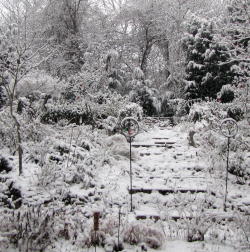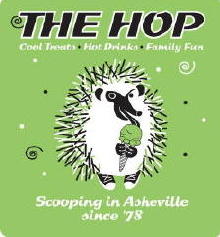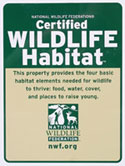
C’mon, this way, I want to show you something else up here at the top of the Fairegarden.

We are almost there. It is the Eryngiums in bloom that are calling to us. Not the North American prairie native Eryngium yuccifoliums in the foreground though, they are not quite blooming yet, although lovely in bud. It is the Europeans showing off at the moment, Eryngium alpinum seedlings of various mixes.

The earliest light of the morning casts a pink tint on the stone grey shed. Viewed from the next terrace down from the top, the middle pathway, the Shed Bed is sparkling with dew. The mix of Eryngiums, Stipa tenuissima and the iris-like foliage of Belamcanda chinensis sets the scene just before the bright light washes the colors out.

The Eryngiums have spread through self sowing over the years until the bed is nearly full.

Getting the balance between the three main players growing in this sunniest, driest spot has been challenging but fun. They all self sow and can get messy looking later in the season.

The slope is quite steep, necessitating the use of stakes in the past to help keep all of the occupants upright and shoulder to shoulder. The black metal container trellises have been added this year and give a more elegant touch.

To keep the use of the metal helpers to a minimum, the stems are twisted together in such a way to make use of those plants on the higher ground giving a lift to those below. The stiff and spikey collars help keep the twist from unfurling.

The efforts each year to capture the true blue-ness are lessons in frustration. As the flowers, the small button heads are comprised of many blossoms, mature, the bracts and stems become a steely shade of periwinkle blue. There are cultivars with names like Sapphire and Blue this and that, but these are mixed seedlings from years of interbreeding. Most are the same color, but there are various leaf shapes.

In an ongoing effort to add diversity to the Fairegarden Eryngium family, besides the E. yuccifolium have been added Eryngium venustum, above and Eryngium tripartum, not shown. These may not add anything new to the genetic miasma, but the foliage is interesting.

It has taken years to get the seed germination going with these Sea Hollies, even though the references all claimed it to be easy peasy. Each winter the spent flower stalks were allowed to stand, becoming fully ripe. Each January when clean up is done, the seedheads were crushed and scattered about throughout the bed. This past January, one seed head was thrust into the ground, marked by the upside down stem. This is what emerged. The tell tale leaves of the baby Eryngiums look so much like the wild violets that one must get down quite low and examine the shape and scalloping to be sure of who is whom. It has been learned that the difference is in those scallops, and the shape will be either round or ovalish/oblong but similar to the heart shape of the violets. They are often shiny, but not always, as well. The little viola decided to adopt the Eryngium as a sibling, both self sown and both welcome here.
One of our earliest posts, click here to view it, published in January of 2008, tells the story of our efforts to get the Eryngiums going here. At that time the photos were not resized as they are now, to save space and prevent piracy, so the shots in the old post may be clicked upon to enlarge. Seeing how the garden has grown since then is enlightening and enjoyable for the gardener, too.
Quick facts:
Zones 5-9
Full sun
Low water
Must have good drainage
Poor soil is fine
Pollinators love it
Tap rooted, move only small seedlings
18-30 inches tall, upright, thistle-like
Whole plant turns steel blue
Frances









I know it isn’t easy peasy to get these things established. I have tried it several times in the past. I guess it is too wet here in my garden. I haven’t found a spot they like. I don’t even see them for sale around here any more. I think the texture and color is so dramatic. Your patch sure looks good. I like the angle you have of your garden in the first photo. It looks like you live on the side of a mountain. Have a great week.
Dear Frances, Sea Holly heaven! The blue is ~perfect. I love Sea Holly and am thrilled to have one in a container ! There are very few spots at c&l that are dry enough during the winter to keep this beauty alive. Having success growing it in a container makes me hope that I can have them all the time. I will follow your advice to Lisa and look for the species seeds. Chiltern or is there a USA source? Again, they are stunning and your close ups are marvelous. xxoogail
Frances, you must be a mind reader. I wanted to try some of these in my new flowerbed, but didn’t order any this spring . Now I see Bluestone Perenneials has them on sale, and I’ve been debating about ordering them. I’ll take your advice to find a very dry spot for them.
I’ve come to admire the sea hollies in recent years. They are a wonderful color. Yours look so happy. I think they hate my garden. I like your solution for their floppiness.
I also love Sea Holly as well as globe thistle. Believe it when i say that rabbits (maybe deer) ate mine. I sowed rattlesnake master seeds last year and I think I have some results this year! I shall see if they are resistant to critters.
Spectacular. I love your crafty twisting!
I have tried these from seed a number of times. Now I am getting some plants from a fellow blogger, so I am super-excited to try them. Thanks for all of the cultural info. I hope it helps.
Wow. The Sea Holly looks beautiful! That’s a lovely garden you have there. May I ask what temperature do you keep it in? I wish i was warm all year long where I live so I can garden as well.
I sure do have to give it a try one of these days when the weather is nice and warm. May I ask what degrees is necessary for the Sea Holly to grow in? It is relatively a great change of temperature here, would you think that it will affect it from blooming? Glad you have a long growing season to be active in the garden. Thanks!
Thanks Frances for being so helpful! That sounds great, I would think that it has to be kept in warm weather year round. This makes it possible for me to grow the Sea Holly. This may be a very simple, beginner question, but how do you know what zone you are in? I tried to search for it on Google, but didn’t have any luck doing so. Thanks again for all of your help!
Love that shot in the first pic. That blue is so pretty. I have seen these plants before & thought they were pretty. Thought about trying them here. Need to check to see if they will grow here.
A wonderful tour in your garden. I always enjoy those.
Waaaaa Hoooooo, we got our first real rain here today. But it was a bit too hard. I’m sure my carrot seeds are bye-bye. I had planted them with some tomato plants I had set out. Will see.
I have this lovely plant in my garden too. I love the spikey look and the beautiful blue grey colour. V
Frances, Your header photo is beautiful. Things continue to change and change and change! New shed? I had to laugh – last year I planted Sea Holly seedlings given me by a garden blogger. I planted them in my bed and in a friend’s bed. Guess what I did?? Well, I’ll tell you. The plants were such early growers and HUGE Leaved, I thought they were weeds and attacked them! However, they returned this year (!) and I thought I’d best see what they’d do. I think I’m going to be Very Happy this year! 😉 lol
This is a plant that I must touch each time I see it. We have had a run on this plant at work and have sold out. They must be reading your blog.